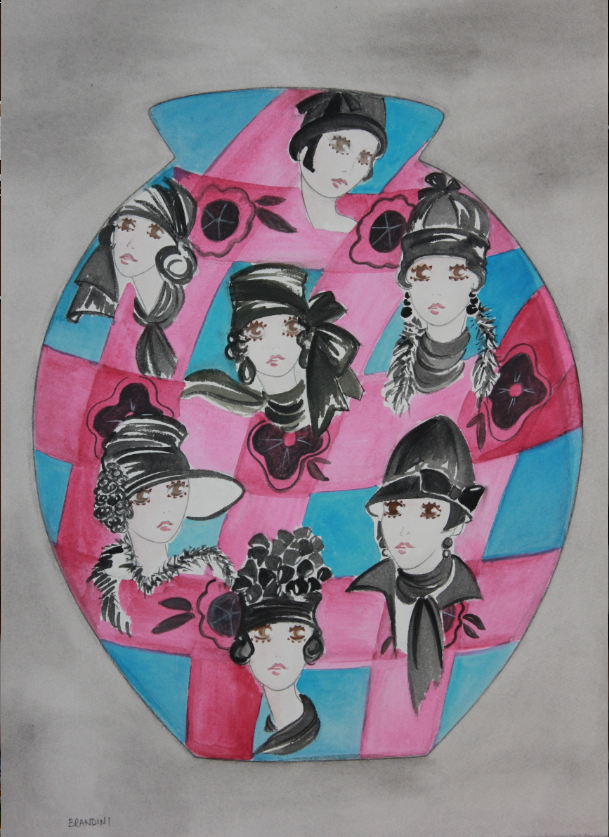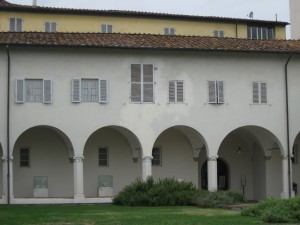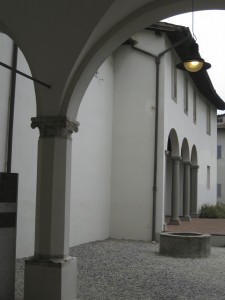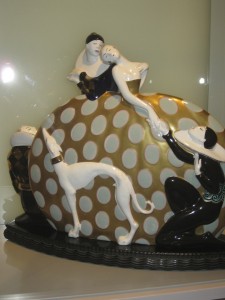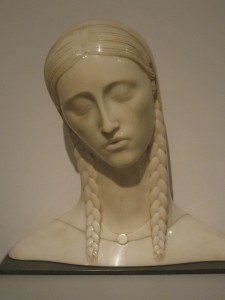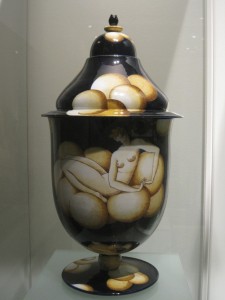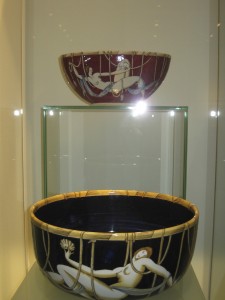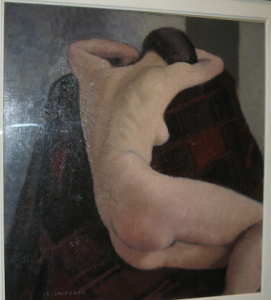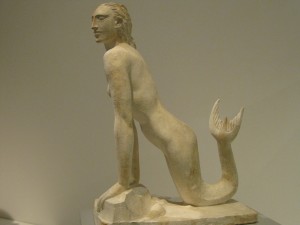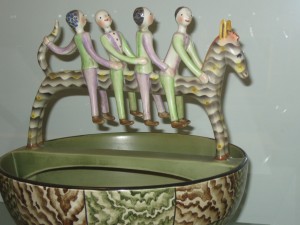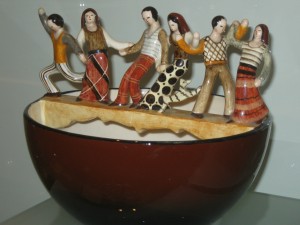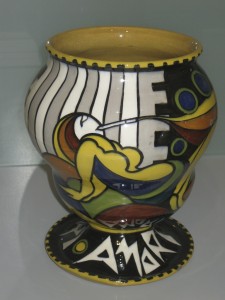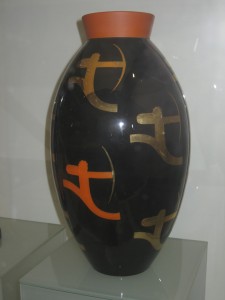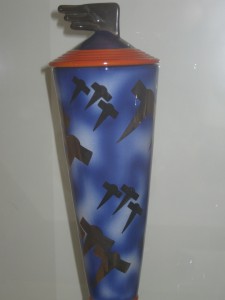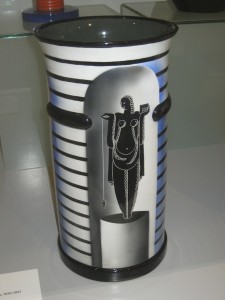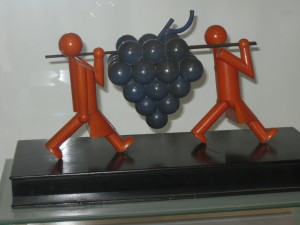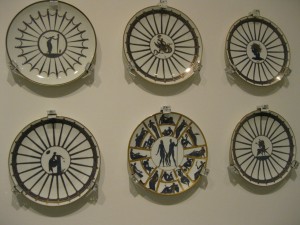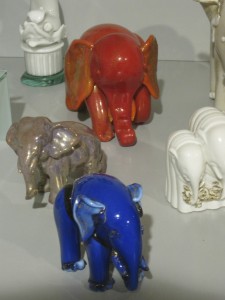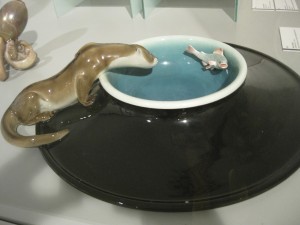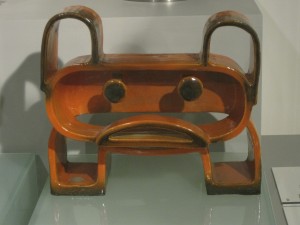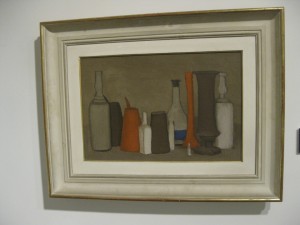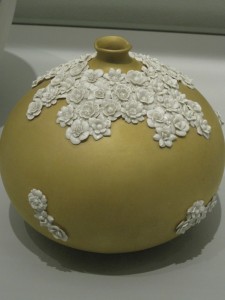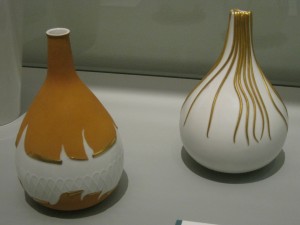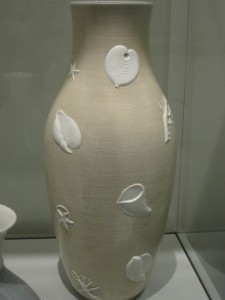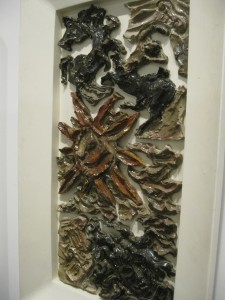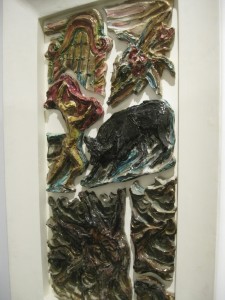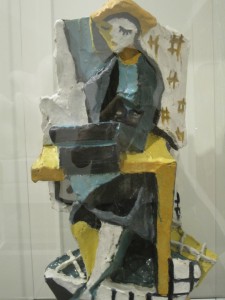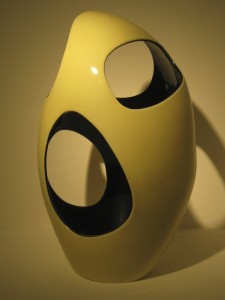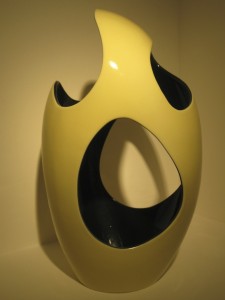Banner of the exhibition
“Scenes of woman” vase invented by Beatrice Brandini
In Lucca until October 6 there is a beautiful exhibition: The Strength of Modernity, arts in Italy from 1920 to 1950, at the Foundation Center studies on Lycia and Carlo Ludovico Ragghianti.
Glimpses Cloister San Micheletto, venue of Ragghianti Foundation
Abstract: “The Centre for Studies on the art of Lycia and Carlo Ludovico Ragghianti” was born in 1981 by the donation of the Ragghianti’s spouses about their Bibloteca, the photo library and archive to the Cassa di Risparmio di Lucca. In 1985, the center becomes a Foundation with the support of the Cassa di Risparmio di Lucca, Tuscany Region, Province and Municipality of Lucca. The primary purpose of the Foundation is to provide a tool for art study, history and in the present. In fact Ragghianti called for a permanent laboratory study and a center of cultural experiences.
The exhibition was made possible thanks to the collaboration with the prestigious museums of Genova, Faenza, of Doccia and Feltre and numerous private collectors, which have enabled us visitors to admire objects of extraordinary beauty.
A little ‘as was the case for the exhibition Great masters and small sculptures, I do not seem to have been greatly publicized, at least not as much as it deserves. And ‘in fact is beautiful exhibition, with a huge amount of work and all of the highest level. It’s worth seeing, I say it often when it comes to art, but in this case I say it with greater enthusiasm.
The strength of Modernity wants to emphasize and enhance the high quality creative and productive the decades that preceded the birth of the Italian Design, characterized decades, as evidenced by the exhibits, from a very high and refined taste, with internationally recognized artists, real as icons of art and design (Gio Ponti, Pietro Melandri, Bruno Munari Adolfo Wildt, Dante Baldelli, Lucio Fontana, etc..).
The theme is the pursuit of modernity as an impetus to a search unstoppable desire for innovation, sometimes with nostalgic echoes that look to the classic, sometimes with completely new themes, ironic and strong, such as the Futurist aesthetics.
Francesco Nonni e Anselmo Bucci Damina with Pierrot 1927
Adolfo Wildt Mother 1929
This work was exhibited at the Roman Quadrennial in 1931.
Gio Ponti Fabrizia Vase 1925, for Manufacture Richard Ginori
Gio Ponti Bowl Emerernziana 1925-28 e Donatella 1925-30, both per Richard Ginori
The three tiles belong to the family known by the title “My women,” which uses the iconographic tradition which emerged in Faenza at the end of the fifteenth century, called just “Beautiful women”. Obviously Ponti modernized the theme making these female figures most current and sensual. There are echoes of the Mannerist sculptors, as Ammannati and Cellini, but also Modigliani, with the oblique eyes. Gio Ponti is for me the most elegant and refined architect and designer of the twentieth century’s. I love everything that has done in its beautiful and rich career.
Felice Casorati Abandonment or Nude from the back, 1929
Salvatore Cottone Siren 1934
Mario Sturani Bowl Four Horsemen 1934, The Bridge / Peasants dancing 1931-32, both for the manifattura Lenci
My favorite! Sturani combines humor, fantasy and deep knowledge of the techniques of painting and sculptural. Despite the great inventiveness, I add also modernity if we consider that are two works of the ’30s, the objects remain very elegant, also thanks to the color combinations.
Tullio Mazzotti Vase Loves – Flowers for the manufacture Giuseppe Mazzotti 1929
In this vase Mazzotti distorts both the shape and the decoration. There is indeed a bulge in the upper central, which leads the observer to have different perspectives as he moves. The decoration refers to advertising graphics, especially thanks to the black lines that surround all the decorative elements, and the word “typography” on the foot of the vase.
Dante Baldelli Archers Vase, Vase with lid and winged aircraft, 1930-31 Vase with allegories, 1935 for the manufacture Rometti
In the beutiful Baldelli’s ceramics we can note futurist ideas, but also those related to European experiences, Austrian and German Bauhaus. Wonderful!
Pippo Rizzo Carriers Grape 1927
Another great sculpture! Echoes futuristic of Balla and Depero.
Gio Ponti Dishes 1925-30, all for Ceramic Society Richard Ginori
Group of dishes belonging to the porcelain family entitled “The love of antiquity.”
Napoleone Martinuzzi elephant in blue glass 1930 Glass Red and White Elephants, 1932, all the hand-blown glass from Murano Venini & C.
Martinuzzi at the end of the 20s introduces on Venini’s catalog Venini a series of small sculptures of animals, renewing a tradition of Murano glass developed in the Baroque, or the production of blown glass objects in the shape of animals, as a basis for lamps or bottles. The Martinuzzi’s bestiary is imaginative, playful and elegant.
Felice Tosalli Otter and salmon1932 for the Manufacture Lenci
Bruno Munari Buldog 1934 for the Manufacture Giuseppe Mazzotti
Munari has done many things throughout his career, it was a truly multi-talented artist. He has also worked in sculpture, even if only in a short period, the futurist. The work shows in fact, is made with shapes that resemble those mechanical, and the color, orange with brown patches, is as an oxidized metal.
Giorgio Morandi Still life 1938
Giovanni Gariboldi globular vase, Vase with pear-shaped and Vase with scrolls and beards, all from 1935-37
Giovanni Gariboldi vase with decoration marine in relief 1940
I also found these vases very beautiful, almost all of Giovanni Gariboldi.
Gariboldi began working with St. Christopher, pottery factory owned by the Ginori. In manufacturing will soon become a contributor to Gio Ponti, (thanks to the confidence and esteem that Ponti has for the young “student”), this successful collaboration between Gariboldi and Ginori will end only at the beginning of the seventies, culminating in 1946 when he appointed creative director.
Lucio Fontana two of the four ceramic bas-reliefs for the Conte Grande 1949
Around 1950 the architect Gio Ponti and Nino Zoncada are commissioned to design the interior of the first class of the Conte Grande transatlantic, boat which will link Italy with South America. Ponti understands that this is a wonderful opportunity to export and promote in the world the great Italian art, as our rich culture. For this reason he contacts the greatest Italian artists of that time, and among these there is Lucio Fontana. Fontana provides his latest works in ceramics, four bas-reliefs.
Leoncillo Typist 1950
Influences of Boccioni, Léger, Picasso ….
This exhibition will also highlight how an object of common use, such a vases, can be interpreted by an artist in an autonomous and independent way, to become the protagonist of the different styling options that in those years ranged from the deco to the second futurism, from abstraction to the common petty bourgeois art.
The exhibition is divided into three major sections: the twenties, the thirties and the forties, with a small nod to the early fifties. On display are more than 300 pieces, objects, sculptures and paintings, with a joint issue that helps the visitor to find and understand the synergies between the various works.
Antonia Campi Umbrella 1949 for the Italian Ceramic Company Levano
We see that the artist feels influenced by the artistic innovations introduced by Moore and Fontana, however the aesthetics of this object is innovative, modern and elegant.
I left refreshed and this feeling of satisfaction and bliss has accompanied me throughout the day, confirming that the beauty in any form is hidden creates harmony and positivity, a big thank you to the organizers and great artists, the real protagonists.
Good life to all!
Beatrice



